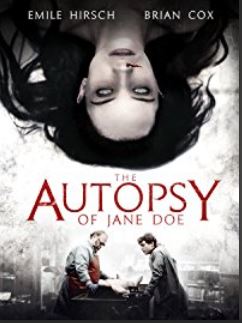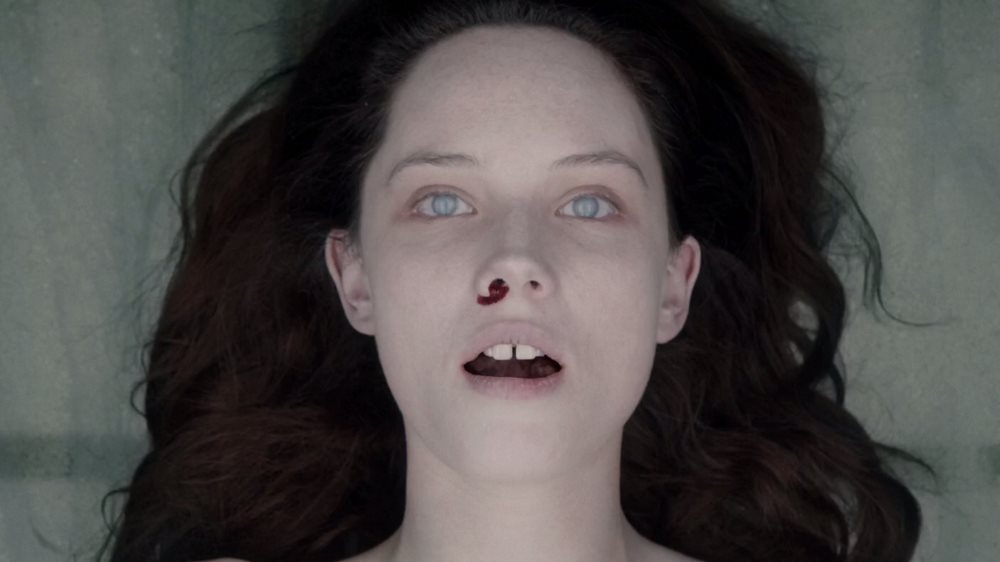When we ‘see what’s on the slab’ in the horror genre, it tends to be a young woman. Some of the films in question are just plain gut-wrenchingly horrific (such as Nacho Cerda’s Aftermath), some are undoubtedly horrific, but all the same cleverer than many might give them credit for (Deadgirl) and then – there’s The Autopsy of Jane Doe, a film which is quite unlike the vast majority of its predecessors, despite presenting us with yet another anonymous, unsullied female cadaver. This in itself is unusual; when you consider that this is the third feature by André Øvredal, it goes from ‘unusual’ to ‘bloody weird’. Yeah, this is the guy who directed the Norse legend-based Trollhunter before it all went strangely quiet on that front, considering the modest but solid reception which the earlier film garnered. Hey, no one can ever accuse this man of sticking to what he’s tried and tested before: this latest film, some six years on, is a bizarre change in direction. However, it has the nous to go all in, melding body horror to something which goes far beyond any of that, with our ‘Jane Doe’ positioned at the centre as if in the middle of a grisly Venn diagram.
We start with a crime scene: a number of dead bodies are discovered at an address, each of which appear to have died a violent death. That is, except for a young woman discovered in the basement. Nude, partially covered by soil, and deceptively intact, she has no distinguishable marks or ID and as such takes the moniker of ‘Jane Doe’, before she’s tagged, bagged and dispatched to a local morgue – the Tilden Morgue, run by a father and son team, dad Tommy (Brian Cox – no, not the physicist) and son Austin (Emile Hirsch). In their line of work, they solve mysteries – as unpalatable as the role must seem to the vast majority of people, finding a cause of death is an invaluable skill – and so they agree to work into the night to try to ascertain what offed their Jane Doe, though not before a couple of neat sequences which allow us to see that these guys know what they’re talking about.
They go to work and, the more they find, the weirder it gets. The girl has peat under her nails. Peat is not a common thing in their neck of the woods. Her ankles are broken, but there’s no bruising on the surface of the skin. Her tongue has been severed – not bitten, cut – and all of that’s before they actually move onto the next phase of the procedure, which is opening the body cavity… Clearly this is no ordinary case, and soon these cool-headed men of science seem to be butting heads with something decidedly unscientific. How could this body be in this condition? What does it all mean?
 The process of Tommy and Austin finding this out serves as the basis for a film which is a real (un)pleasant surprise, and genuinely gripping. I’ll admit, my first concern after the opening scenes where Jane Doe – played with surprising personality by Olwen Kelly – seems to be posed in the earth was that this was going to be an uncomfortably sexualised film. To the credit of the writer, director and actors, it did not after all feel that this was the case. The two men are consummate professionals; they don’t leer or comment on the girl’s appearance, they stick to their roles, and the shots are non-gratuitous. Yes, the film is uncomfortable viewing in places, but because it’s creepy and unflinching: Jane Doe is a case, that’s all, but the gradual reveal of what has happened to her only underlines the vulnerability of this girl – further plot developments show that yes, it’s women’s bodies that are shown as embattled, but considering the direction which the plot takes, this actually makes solid sense. If I have any quibbles about this plot shift it’s only that I saw a film fairly recently called Unrest (2006) which has quite a lot of similarities to The Autopsy of Jane Doe – and don’t read the synopsis of that one if you’ve never heard of it, as it may spoil the film now under discussion. However, The Autopsy of Jane Doe more than stands up, in my mind, against the earlier movie, despite a few moments of deja-vu – a very small set and a tiny cast, one completely voiceless and motionless, are able to see this film through a myriad of twists and turns. It pulls no punches in its depiction of the mortician role, it’s meticulously detailed, neatly-handled, economical, with a tight script and lines heavy with significance. Austin’s utterance that things are getting “way past possible” is a decent summary of where this film eventually takes us. I also liked the way little throwaway comments were picked up and embedded in the story later on.
The process of Tommy and Austin finding this out serves as the basis for a film which is a real (un)pleasant surprise, and genuinely gripping. I’ll admit, my first concern after the opening scenes where Jane Doe – played with surprising personality by Olwen Kelly – seems to be posed in the earth was that this was going to be an uncomfortably sexualised film. To the credit of the writer, director and actors, it did not after all feel that this was the case. The two men are consummate professionals; they don’t leer or comment on the girl’s appearance, they stick to their roles, and the shots are non-gratuitous. Yes, the film is uncomfortable viewing in places, but because it’s creepy and unflinching: Jane Doe is a case, that’s all, but the gradual reveal of what has happened to her only underlines the vulnerability of this girl – further plot developments show that yes, it’s women’s bodies that are shown as embattled, but considering the direction which the plot takes, this actually makes solid sense. If I have any quibbles about this plot shift it’s only that I saw a film fairly recently called Unrest (2006) which has quite a lot of similarities to The Autopsy of Jane Doe – and don’t read the synopsis of that one if you’ve never heard of it, as it may spoil the film now under discussion. However, The Autopsy of Jane Doe more than stands up, in my mind, against the earlier movie, despite a few moments of deja-vu – a very small set and a tiny cast, one completely voiceless and motionless, are able to see this film through a myriad of twists and turns. It pulls no punches in its depiction of the mortician role, it’s meticulously detailed, neatly-handled, economical, with a tight script and lines heavy with significance. Austin’s utterance that things are getting “way past possible” is a decent summary of where this film eventually takes us. I also liked the way little throwaway comments were picked up and embedded in the story later on.
I’m fighting against myself not to talk about what happens when the film pulls its big reveal, by the way. I think that’s a credit to the film, too – I want to discuss it all. But I wouldn’t do that to you…
So – The Autopsy of Jane Doe was not at all what I was expecting from André Øvredal, but I adored Trollhunter and, after my initial surprise, I really like his newest work too; I’m now even daring to hope that we can say we have an innovative, confident director on our hands here who has shown the capacity to turn his skills to very different fare, even across only two films, and he will hopefully get something else made before another six years rattle past us. This is a film which has done what actually very few films have done well – linking very visceral, earthly horror with supernatural horror, or marrying science with superstition. It doesn’t get much more earthly than a morgue, but then, the film moves beyond this realm very successfully too. It’s a pretty ferocious experience, all things considered.
The Autopsy of Jane Doe is available from today (19th June 2017) on EST and comes out on DVD, Blu-Ray and VOD on 26th June 2017.
